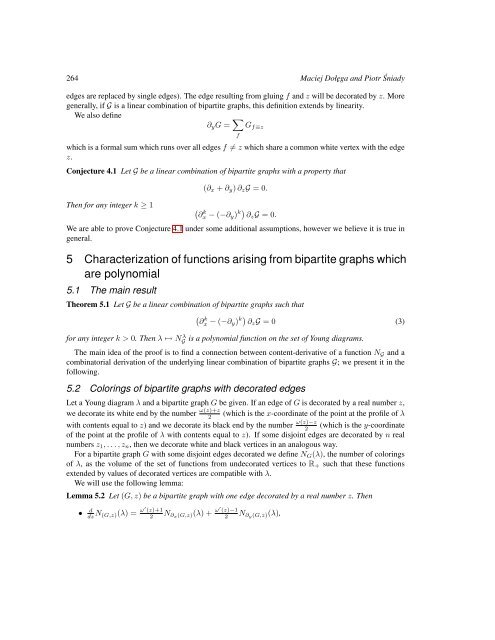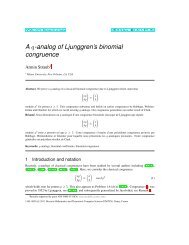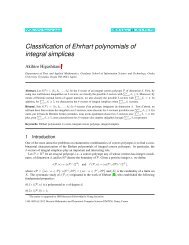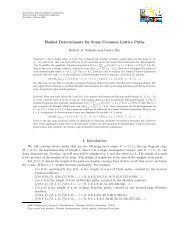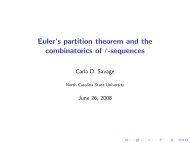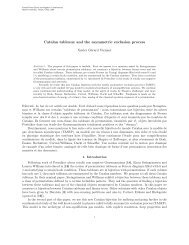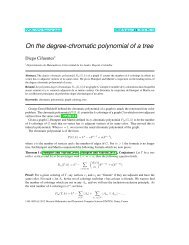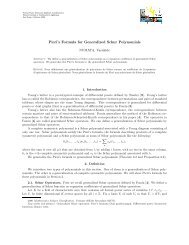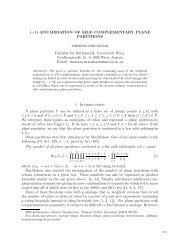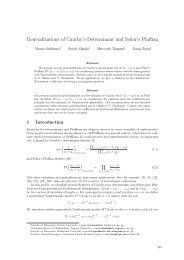Polynomial functions on Young diagrams arising from bipartite graphs
Polynomial functions on Young diagrams arising from bipartite graphs
Polynomial functions on Young diagrams arising from bipartite graphs
Create successful ePaper yourself
Turn your PDF publications into a flip-book with our unique Google optimized e-Paper software.
264 Maciej Dołęga and Piotr Śniady<br />
edges are replaced by single edges). The edge resulting <strong>from</strong> gluing f and z will be decorated by z. More<br />
generally, if G is a linear combinati<strong>on</strong> of <strong>bipartite</strong> <strong>graphs</strong>, this definiti<strong>on</strong> extends by linearity.<br />
We also define<br />
∂ y G = ∑ G f≡z<br />
f<br />
which is a formal sum which runs over all edges f ≠ z which share a comm<strong>on</strong> white vertex with the edge<br />
z.<br />
C<strong>on</strong>jecture 4.1 Let G be a linear combinati<strong>on</strong> of <strong>bipartite</strong> <strong>graphs</strong> with a property that<br />
(∂ x + ∂ y ) ∂ z G = 0.<br />
Then for any integer k ≥ 1 (<br />
∂<br />
k<br />
x − (−∂ y ) k) ∂ z G = 0.<br />
We are able to prove C<strong>on</strong>jecture 4.1 under some additi<strong>on</strong>al assumpti<strong>on</strong>s, however we believe it is true in<br />
general.<br />
5 Characterizati<strong>on</strong> of <str<strong>on</strong>g>functi<strong>on</strong>s</str<strong>on</strong>g> <strong>arising</strong> <strong>from</strong> <strong>bipartite</strong> <strong>graphs</strong> which<br />
are polynomial<br />
5.1 The main result<br />
Theorem 5.1 Let G be a linear combinati<strong>on</strong> of <strong>bipartite</strong> <strong>graphs</strong> such that<br />
(<br />
∂<br />
k<br />
x − (−∂ y ) k) ∂ z G = 0 (3)<br />
for any integer k > 0. Then λ ↦→ NG λ is a polynomial functi<strong>on</strong> <strong>on</strong> the set of <strong>Young</strong> <strong>diagrams</strong>.<br />
The main idea of the proof is to find a c<strong>on</strong>necti<strong>on</strong> between c<strong>on</strong>tent-derivative of a functi<strong>on</strong> N G and a<br />
combinatorial derivati<strong>on</strong> of the underlying linear combinati<strong>on</strong> of <strong>bipartite</strong> <strong>graphs</strong> G; we present it in the<br />
following.<br />
5.2 Colorings of <strong>bipartite</strong> <strong>graphs</strong> with decorated edges<br />
Let a <strong>Young</strong> diagram λ and a <strong>bipartite</strong> graph G be given. If an edge of G is decorated by a real number z,<br />
we decorate its white end by the number ω(z)+z<br />
2<br />
(which is the x-coordinate of the point at the profile of λ<br />
with c<strong>on</strong>tents equal to z) and we decorate its black end by the number ω(z)−z<br />
2<br />
(which is the y-coordinate<br />
of the point at the profile of λ with c<strong>on</strong>tents equal to z). If some disjoint edges are decorated by n real<br />
numbers z 1 , . . . , z n , then we decorate white and black vertices in an analogous way.<br />
For a <strong>bipartite</strong> graph G with some disjoint edges decorated we define N G (λ), the number of colorings<br />
of λ, as the volume of the set of <str<strong>on</strong>g>functi<strong>on</strong>s</str<strong>on</strong>g> <strong>from</strong> undecorated vertices to R + such that these <str<strong>on</strong>g>functi<strong>on</strong>s</str<strong>on</strong>g><br />
extended by values of decorated vertices are compatible with λ.<br />
We will use the following lemma:<br />
Lemma 5.2 Let (G, z) be a <strong>bipartite</strong> graph with <strong>on</strong>e edge decorated by a real number z. Then<br />
• d dz N (G,z)(λ) = ω′ (z)+1<br />
2<br />
N ∂x(G,z)(λ) + ω′ (z)−1<br />
2<br />
N ∂y(G,z)(λ),


